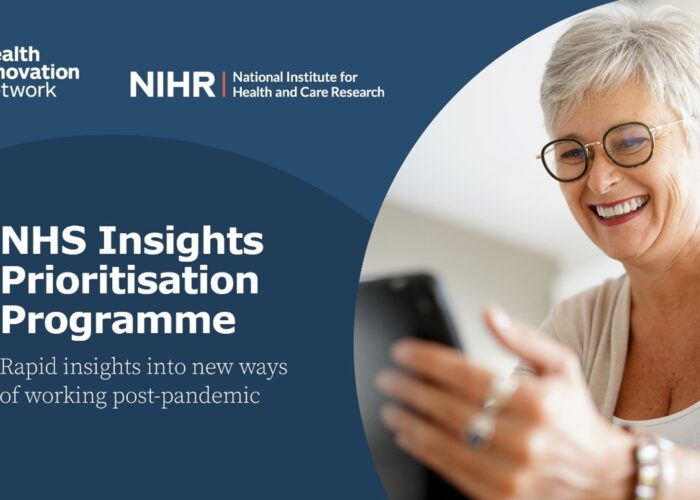New national chart to be rolled out in North West London seeks to join up treatment of acutely ill children across health care settings
Charlotte Douglas, former Innovation Advisor at Imperial College Health Partners, describes how the new National PEWS chart exemplifies integrated care, and the ambition locally for Northwest London.
When a child becomes unwell, the paediatric care pathway could potentially involve numerous different providers across the care system, from community to acute. This means that a child in care could be seen by multiple healthcare professionals, meaning that lots of time is spent doing clinical handover, as well as requiring the child’s parents or family to retell their child’s healthcare story potentially many times.
The Paediatric Early Warning Score (PEWS) chart, designed by NHS England and Improvement in collaboration with the Royal College of Paediatrics and Child Health, and the Royal College of Nursing is a new national quality improvement tool that supports clinical teams by ensuring all information regarding the patient is captured in one place. It is being rolled out in multiple healthcare settings across England, as part of NHS England’s national commitment to collaborative working. Currently, the primary focus is on implementing the national PEWS charts into acute settings, but the national ambition is to scale and spread PEWS into other departments, including A&E, ambulance, and community care, meaning the approach to childcare is standardised across the system, regardless of location, provider, or service. As such, PEWS is a truly exemplary model of the Integrated Care System at work.
A standardised, patient-focused approach
The ambition is that a single PEWS chart will now follow the same child throughout their care provision. The nurse or doctor caring for the paediatric patient will measure many physiological factors, such as blood pressure and oxygen saturation, known as observations, that are recorded on the chart as a numerical score. The same approach will be taken at every Trust, meaning that clinicians will not need to be retrained at different sites, enabling our colleagues to work in a unified way. The standardisation of PEWS thereby creates a universal shared language, maximising the effectiveness of responding to a child’s health needs and positively impacting the health of our paediatric population.
Moreover, family, parents, or carers, who often know the child more astutely, may have an intuitive feeling regarding their child’s health, and may be able to detect a problem before the child possibly deteriorates. Although some Trusts often involve the parental voice in treating unwell children, the new PEWS chart proactively records and documents this information, thereby also ensuring the parents/family do not have to repeat themselves to different healthcare professionals.
Importantly, capturing parental intuition about their child improves communication between healthcare staff and parents/carers, and empowers the parent/family to engage with their child’s healthcare provider thus,. the PEWS tool helps clinicians to provide the best quality of care to the paediatric patient through quality improvement.
A focus on sharing
At Imperial College Health Partners, the Academic Health Science Network (AHSN) for Northwest London, we are supporting the implementation of PEWS in four acute Trusts through our Patient Safety Collaborative. We are working closely with our ICS partners, NHS frontline colleagues, NHSE/I colleagues and other paediatric networks to best support our Trusts to ensure they feel confident enough to join the national PEWS rollout, which it is our collective ambition is to do later in the year. Upon discussion with Clinicians in our local Trusts, they believe that implementing a standardised PEWS Chart will enable better training due to standardisation, the framework will support iterative and on-going quality improvement, and the Chart will enable valid and comparative studies on outcome measures in the future.
Locally, we have planned and delivered our first paediatrics-focussed Patient Safety Network events, which bring together colleagues who work across the paediatric patient journey. Participants can network and share learning in a safe and empowering space, enabling them to use others’ experiences to improve paediatric patient safety in their own settings and services, which our colleagues are so passionately committed to. The ambition is to scale-up these networks to encompass all-cause deterioration, enabling colleagues across the entire patient pathway to share learning on positively impacting patient safety in our local area. To add further value at a national level, using insights gained from our own NWL rollout, we also recently developed a ‘Readiness Checklist’, which is designed to support our frontline healthcare providers, and our national AHSN colleagues, with taking implementation theory into delivery as they embark on the PEWS implementation journey by offering a formalised ‘to do’ list they can follow.
Phase one PEWS testing in England is well underway and has garnered positive feedback.
To find out more information about national PEWS roll-out in the acute paediatric space, or if you are interested in attending the all-cause Deterioration-focussed Patient Safety Network meetings, please email Kenny.Ajayi@imperialcollegehealthpartners.com.



